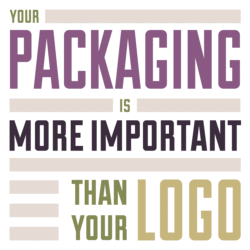Sometimes brands work so hard to convey what they want the consumer to understand about them—who they are and what they stand for—that they miss a very important piece of the puzzle when it comes to their packaging. The primary focus should be to communicate the most important selling points to the consumer instantly and succinctly. The brand story definitely plays an important role and strengthens the emotional connection with the consumer, but ultimately the goal is that they pick up the product and buy it. Promoting the brand first will not achieve this. Promoting the product’s key features will.
Think as if were the consumer. Knowing nothing about the product, you happen upon it in a store, on the shelf among many other products. You’re in a hurry and there are distractions. What would convince you to buy it? Remember, the package only has 2–3 seconds to achieve this.
Here are three common pitfalls:
1. Making the logo the main focus.
This works for huge brands such as Coca-Cola and Pepsi because they have invested tons in advertising over a very long period of time. However for boutique and emerging brands, the brand mark should take a back seat to the product name. If consumers don’t understand what the product is at first glance, they aren’t likely to buy it.
2. Talking about ‘me, me, me’ instead of what’s in it for them.
The brand story is a very important part of the package. However, when you talk about the brand first and the selling points second, it’s not strong enough to convince the consumer to buy the product in those 2–3 seconds.
Think about it this way: picture yourself at a social or networking event, someone you don’t know starts a conversation with you and all he talks about is himself. Do you find it interesting? How about if he first engages you by taking an interest in who you are and what you do. We’re more likely in the latter example to have a meaningful connection with him and take more of an interest in what he’s talking about.
Communicate the most important selling points to the consumer on the front of the package, and put the brand story in a secondary position.
3. Assuming the customer already knows.
When determining what information to put on the package, always assess your target audience. Are they familiar with your product and its features, is it all new to them, or is it a mix of the two? Make sure you’re speaking to both ends of your audience spectrum. Don’t worry about including information they may already know. For those in the know, it’s only confirmation of why they’re buying it. For those that need educating, they’ll appreciate the clear and inclusive information that introduces them to the product.
When you assume they already know something that they don’t, confusion sets in, which leads to frustration or disinterest. Remember, packaging is your most important selling tool, and clear communication is of utmost importance.
How do you make sure you’re on the right track in speaking to the customer?
Step back and look at the big picture.
As you’re developing your packaging, take a look at it with fresh eyes frequently. Remember the main goal—motivating the consumer to buy the product—and the 2–3 second window of opportunity. Is the package doing what it needs to achieve that? Is your information clear and concise? Does the front of the package communicate the key selling points?
Ask around.
It’s a great idea to ask those who know little about the brand or product to take a look at the packaging—with no explanation—and get their input. Line it up with competitors and get feedback that way, too. After all, when your product stands on the retail shelf, it is among competing products, and there is no one there to explain it.
The more you can look at your packaging from the point of view of your consumers, the more you will be able to gauge how effectively the packaging is communicating. Use this information to guide and hone the language and layout for maximum results.





All true points, and a great reminder, thank you!
Thanks, Erik!
Great article! I can see our many conference calls and discussions reflected in the article and on what is now a final multi package design for our products!
Thank you for the wonderful job you did with our packaging.
Looking forward to working with you soon.
Guy Lopez
Thanks, Guy!
Awesome article
Thanks, Diego!
Fantastic information thanks